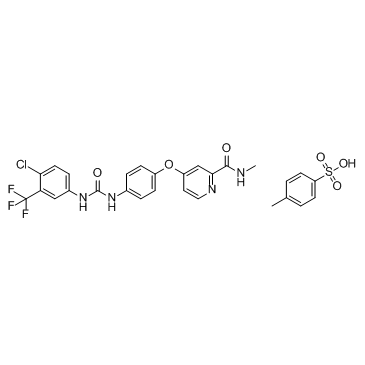475207-59-1
| Name | sorafenib tosylate |
|---|---|
| Synonyms |
Sorafenib Tosylate
Bay 43-9006 4-[4-[[4-chloro-3-(trifluoromethyl)phenyl]carbamoylamino]phenoxy]-N-methylpyridine-2-carboxamide,4-methylbenzenesulfonic acid Sorafenib (Tosylate) |
| Description | Sorafenib tosylate is a potent multikinase inhibitor, with IC50s of 6 nM, 20 nM, and 22 nM for Raf-1, B-Raf, and VEGFR-3, respectively. |
|---|---|
| Related Catalog | |
| Target |
VEGFR3:20 nM (IC50) Braf:22 nM (IC50) Raf-1:6 nM (IC50) VEGFR2:90 nM (IC50) BrafV599E:38 nM (IC50) PDGFRβ:57 nM (IC50) c-Kit:68 nM (IC50) Flt3:58 nM (IC50) |
| In Vitro | Sorafenib Tosylate also inhibits BRAFwt (IC50=22 nM), BRAFV599E (IC50=38 nM), VEGFR-2 (IC50=90 nM), VEGFR-3 (IC50=20 nM), PDGFR-β (IC50=57 nM), c-KIT (IC50=68 nM), and Flt3 (IC50=58 nM) in biochemical assays[1]. Sorafenib-induced phosphorylation of c-Met, p70S6K and 4EBP1 is significantly reduced when 10-0505 cells are co-treated with anti-human anti-HGF antibody, suggesting that treatment with Sorafenib Tosylate leads to increased HGF secretion and activation of c-Met and mTOR targets[2]. |
| In Vivo | Sorafenib Tosylate (10, 30, 50 and 100 mg/kg, orally) treatment inhibits the tumor growth of 06-0606 and 10-0505 xenografts in a dose-dependent manner (P<0.01). The growth rate of 06-0606 and 10-0505 xenografts is also significantly reduced by Sorafenib. The weights of 06-0606 tumors in mice that are treated with Sorafenib 50 mg/kg and 100 mg/kg are approximately 13% and 5% of the controls, respectively. 50 mg dose of Sorafenib significantly inhibits tumor growth in mice with lines 5-1318, 26-1004 and 10-0505 (P<0.01). For 50 mg dose, the T/C ratio, where T and C are the median weight (mg) of Sorafenib- and vehicle-treated tumors at the end of the treatment, respectively, for 06-0606, 26-1004, 5-1318, and 10-0505 xenografts is 0.13, 0.10, 0.12 and 0.49, respectively[2]. The survival rate is 73.3 % in Diethyl nitrosamine (DENA) group and 83.3 % in Sorafenib group compared to 100 % in the normal control group. DENA group shows a significant increase in liver index (1.51-fold increase, p<0.05) compared to normal control group, while treatment with Sorafenib shows significant decrease (p<0.05) in liver index when compared to DENA group. The liver index in Sorafenib group significantly decreases to lower than its value in the normal control[3]. |
| Kinase Assay | To test compound inhibition against various RAF kinase isoforms, Sorafenib is added to a mixture of Raf-1 (80 ng), wt BRAF, or V599E BRAF (80 ng) with MEK-1 (1 μg) in assay buffer [20 mM Tris (pH 8.2), 100 mM NaCl, 5 mM MgCl2, and 0.15% β-mercaptoethanol] at a final concentration of 1% DMSO. The RAF kinase assay (final volume of 50 μL) is initiated by adding 25 μL of 10 μM γ-[33P]ATP (400 Ci/mol) and incubated at 32°C for 25 minutes. Phosphorylated MEK-1 is harvested by filtration onto a phosphocellulose mat, and 1% phosphoric acid is used to wash away unbound radioactivity. After drying by microwave heating, a β-plate counter is used to quantify filter-bound radioactivity[1]. |
| Cell Assay | The 10-0505, 06-0606, and 26-1004 tumors are finely minced and washed three times with modified Eagle medium (MEM). Cells are harvested by centrifuging at 800× g for 10 min. Cells are treated with 3 or 6 μM of Sorafenib in serum free MEM in the presence or absence of 5 μg/mL anti-human hepatocyte growth factor (HGF) antibody for 48 hrs. A total of 2 mL of conditioned medium from vehicle- or Sorafenib-treated (without anti-human antibody) is collected and concentrated using a VIVASPIN 20 and secreted HGF in conditioned medium is determined by western blotting[2]. |
| Animal Admin | Mice[2] For dose-response experiment, mice bearing the 06-0606 and 10-0505 xenografts are given four doses of Sorafenib (10, 30, 50 and 100 mg/kg daily) orally for 12 days. Each treatment group comprised of five mice. To investigate the antitumor effects of Sorafenib, mice bearing tumors are orally administered 50 mg/kg Sorafenib daily for 12 days. Each treatment group is comprised of 14 animals and each experiment is repeated at least twice. Treatment started on day 7 after tumor implantation. By this time, the HCC xenografts reached the size of approximately 100 mm3. To study the effects of Rapamycin plus Sorafenib on the growth of 10-0505 xenograft, mice bearing tumors (14 per group) are orally administered either 200 μL of vehicle, or 50 mg/kg of Sorafenib, or 1 mg/kg of Rapamycin, or Rapamycin plus Sorafenib daily for indicated days. Tumor growth is monitored at least twice weekly by Vernier caliper measurement of the length and width of tumor. Tumor volume is calculated as follows: [length×width2×π/6]. At the end of the study, the mice are killed with body and tumor weights being recorded, and the tumors harvested for analysis. Rats[3] In the study, 100- to 120-g male albino rats are utilized. After acclimatization period, rats are weighed and randomly divided into three groups: Group 1 (normal control group; n=10) is given the vehicle daily for 8 weeks. Group 2 (DENA group; n=15) receive i.p. single dose of 200 mg/kg DENA. Group 3 (Sorafenib group; n=12) is given Sorafenib orally at a dose of 10 mg/kg daily for 2 weeks, 6 weeks after DENA i.p. injection. At the end of the experiment (8 weeks), rats are weighed, anesthetized by ether, and killed, and their livers are dissected. Fresh liver is washed twice with ice-cold saline, dried on clean paper towel, and weighed. Liver index is calculated as liver weight (g)/final body weight (g)×100. The liver is divided into five portions: one portion is preserved in 10 % formalin for histopathological examination and the other portions are immediately frozen in liquid nitrogen and stored at −80°C. |
| References |
| Density | 1.454 g/cm3 |
|---|---|
| Boiling Point | 523.3ºC at 760 mmHg |
| Molecular Formula | C28H24ClF3N4O6S |
| Molecular Weight | 637.027 |
| Flash Point | 270.3ºC |
| Exact Mass | 636.105713 |
| PSA | 158.59000 |
| LogP | 8.34970 |
| Storage condition | 2~8℃ |
| Hazard Codes | Xi |
|---|


